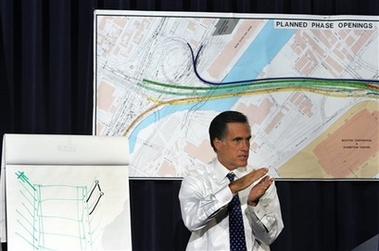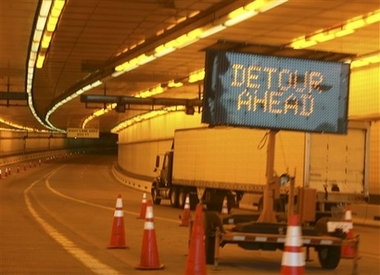More lessons from the tragedy in Boston
 Massachusetts Gov. Mitt Romney talks about the problems with the Big Dig beside a diagram he drew of the tunnel ceiling support system and beneath a map of the Interstate 90 connector tunnels during a news conference at the Statehouse in Boston, Monday, July 17, 2006. (AP Photo/Michael Dwyer)
Massachusetts Gov. Mitt Romney talks about the problems with the Big Dig beside a diagram he drew of the tunnel ceiling support system and beneath a map of the Interstate 90 connector tunnels during a news conference at the Statehouse in Boston, Monday, July 17, 2006. (AP Photo/Michael Dwyer)From the Boston Globe
1. The Inspector General of Massachusetts writes, in "A Fatal Lesson":
That Massachusetts should never again embark upon a major public works project without the help of an objective, independent ``owner's engineer" whose solitary task is to ride herd over designers, managers, and contractors. Owner's engineers, common in the construction of major works, have a single objective -- ensuring that taxpayers get what they pay for. In the case of the Big Dig, that would mean $14.6 billion worth of tunnels that are safe to drive through for decades to come.
Bechtel/Parsons Brinckerhoff was technically supposed to act as owner's engineer on the project. But it had several other responsibilities that directly conflicted with the mandate of an owner's engineer. ...
Lacking a proper owner's engineer on the Big Dig, it was left to a few outside entities to keep an impartial eye on the project. But none of those agencies had the resources, people power, or solitary focus to do the job of an independent owner's engineer. Still, important questions were brought to Bechtel/Parsons Brinckerhoff's doorstep. In December 1998, my office, the Massachusetts Office of the Inspector General, issued a report citing the potential for disaster in the design and construction of the Big Dig's anchor-bolted ceiling system. In response, Big Dig officials, relying on advice from Bechtel/Parsons Brinckerhoff, promised to employ a different ceiling anchor system from then on -- a promise that clearly wasn't kept. ...
A properly empowered owner's engineer cannot simply be dismissed or ignored by contractors, designers, and agency officials. Ironically, my office had contracted with independent engineers whose sole duty was to recheck and question all manner of Big Dig expenses and procedures, but the Turnpike Authority in December 2004 cut funding for such employees after we criticized the agency's handling of leaks in the tunnels. ... Yes, myriad entities had oversight, but none provided intensive, day-to-day, on-site scrutiny of the design and construction of the project, as an independent owner's engineer would have.2. In "Put transit on agenda," columnist Eileen McNamara makes the point that a transportation "system" overfocused on the privately driven automobile can be problematic. She writes:
Maybe now we could begin talking seriously again about mass transit in Massachusetts. If nothing else, the problems with the Big Dig tunnels should put state transportation policy, or the lack of it, back on the public agenda.
Drivers desperate to escape the traffic of the last week, who turned to the T and commuter rail, learned what regular riders already knew: The state's diminishing commitment to mass transit has left us with a fractured system plagued by dirt, delays, deferred maintenance, and declining ridership.
It was not supposed to be like this. The Big Dig was meant to be one part of a more comprehensive transportation scheme. In 1990, environmental groups extracted promises of expanded mass transit from state officials to counter the expected increase in air pollution caused by the Big Dig and to ensure that public expenditures on transportation did not begin and end with cars. To avoid a lawsuit, the Commonwealth agreed to restore dormant train and trolley lines in the city and to expand commuter rail service to outlying areas.
Hmm, like the discussion of the Inter County Connector in Montgomery and (a little bit in) Prince George's County Maryland vs. light rail in the same counties and beyond. See the op-ed piece in the Baltimore Sun, "Don't squander billions on the ICC," by Stewart Schwartz of the Coalition for Smart Growth. From the piece:Neither Maryland nor the federal government can afford to throw away $3 billion or more on an ineffective public works project. But that's exactly what Gov. Robert L. Ehrlich Jr., Montgomery County Executive Douglas M. Duncan and other politicians from both parties will do if they proceed with the Intercounty Connector.
The ICC would drain funding from many sources. Governor Ehrlich proposes to issue nearly $2 billion in public debt, a figure that would increase with rising construction costs. To repay this debt, the state proposes very high tolls, about $7 for round-trip, end-to-end travel between Interstate 270 and Interstate 95 - up to $1,800 per year. Drivers in the Baltimore region and to the Eastern Shore would also face possible toll increases and the planned diversion of their toll dollars to the ICC. Both areas would have fewer funds available to meet their own needs.
Also see the Globe Editorial "MBTA to the rescue," and Commuter rail struggles to meet surge in ridership.3. And of course economics matters too, see " Boston tries to keep Big Dig tunnel fatality from hurting convention and tourism business."
 A sign warns of a detour around the closed connector tunnels for Interstate 90 as a tractor trailer heads into the Ted Williams tunnel westbound from Logan International Airport in Boston, Monday, July 17, 2006. Last week, days after 12 tons of ceiling panels came loose and fell on a car, crushing a passenger, the governor announced that inspections had found at least 242 points where bolts were separating from the tunnel roof. Two Big Dig tunnels have since been closed and Romney has not yet cleared the way for them to reopen. (AP Photo/Michael Dwyer)
A sign warns of a detour around the closed connector tunnels for Interstate 90 as a tractor trailer heads into the Ted Williams tunnel westbound from Logan International Airport in Boston, Monday, July 17, 2006. Last week, days after 12 tons of ceiling panels came loose and fell on a car, crushing a passenger, the governor announced that inspections had found at least 242 points where bolts were separating from the tunnel roof. Two Big Dig tunnels have since been closed and Romney has not yet cleared the way for them to reopen. (AP Photo/Michael Dwyer)Index Keywords: transportation; good-government



0 Comments:
Post a Comment
<< Home